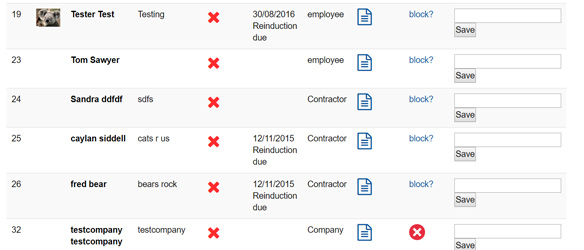Safety Orientation: Why you need a Safety Orientation
Online Orientation >> Orientation Program >> Safety OrientationPublished 14/09/2025
 A safety orientation is a core part of ensuring new employee and contractor safety in the workplace. Ensuring that all new staff and contractors have done a safety orientation is critical for ensuring they work safe and stay safe on site as well as going through important HR policies and procedures.
A safety orientation is a core part of ensuring new employee and contractor safety in the workplace. Ensuring that all new staff and contractors have done a safety orientation is critical for ensuring they work safe and stay safe on site as well as going through important HR policies and procedures.
A safety orientation is an important element of your overall orientation program for new starters to ensure they are aware of, acknowledge and understand important safety measures for working on site and being job ready for their first day in the workplace.
It commonly involves going through a series of orientation steps ranging from collecting information from new starters such as evidence of training, licenses or certifications through to going through a safety orientation presentation, checklist and assessment.
You might conduct a safety orientation as part of your overall Contractor Induction, New Employee Induction and as part of your Contractor Management System.
Why Setup a Safety Orientation
 It's important that all new staff, contractors, visitors or volunteers are prepared for their first day in your workplace and are familiar with policies, procedures, safety and hazard awareness and any risks to be aware of before they start their job task or activity.
Giving them a proper safety orientation will help them be better prepared for working safely in the workplace and hopefully avoid incidents from occurring such as an injury or near miss.
Establishing a good safety orientation also shows you are a proactive and engaged workplace, setting a good culture around safety and that you strive for protecting your workforce.
Not everyone is going to be familiar with the deep intricacies of your workplace, visitors, consultants, contractors or volunteers might only be working there for one day or a short term job task and they equally need to understand important policies and procedures.
It's important that all new staff, contractors, visitors or volunteers are prepared for their first day in your workplace and are familiar with policies, procedures, safety and hazard awareness and any risks to be aware of before they start their job task or activity.
Giving them a proper safety orientation will help them be better prepared for working safely in the workplace and hopefully avoid incidents from occurring such as an injury or near miss.
Establishing a good safety orientation also shows you are a proactive and engaged workplace, setting a good culture around safety and that you strive for protecting your workforce.
Not everyone is going to be familiar with the deep intricacies of your workplace, visitors, consultants, contractors or volunteers might only be working there for one day or a short term job task and they equally need to understand important policies and procedures.
A Safety Orientation might be setup for:
- A whole organisation orientation
- A specific project or work site orientations
- Role based, specific to a particular type of worker such as cleaners, maintenance staff, contractors or volunteers
A safety orientation might also be staged, where there might be pre-day 1 preparation activities before someone arrives on site, day 1 safety orientation, week 1 and even additional courses, training and awareness that might be ongoing at month 1, month 3 and month 6 at the end of a probation period.
Structuring your Safety Orientation
What are some of the most important and popular parts of a safety orientation? Safety on site, what you need to know about working safely in the workplace
Safety on site, what you need to know about working safely in the workplace
 Policies and procedures acknowledgement
Policies and procedures acknowledgement
 Contractor, Employee or Volunteer focused orientations
Contractor, Employee or Volunteer focused orientations
 Testing competency to make sure they understand the orientation content
Testing competency to make sure they understand the orientation content
 Capture licenses / evidence of training
Capture licenses / evidence of training
 Preparing new starters before they start work on important HR and Safety content
Preparing new starters before they start work on important HR and Safety content
Ongoing Safety Orientations
A safety orientation might be done yearly to make sure workers are up to date on all current safety policies, procedures and training. The workplace is constantly changing and it's important that the safety orientation remain up to date and refreshed. Hazards, risks and other safety resources need to be updated and workers need to be re-trained to make sure they are competent.- might be done annually to ensure staff are up to date
- at the start of a new project
- when launching a new site
- when staff begin at a new location or region
- when a new job task or activity is being undertaken that is quite different to their last
Common things to include in a Safety Orientations
 Having a safety orientation is an essential part of any workplace. It helps ensure that everyone understands the regulations and procedures they need to follow while on the job, and also supports compliance with relevant laws and industry standards. Knowing what to include in a Safety Orientation can help you create a comprehensive program that covers all the necessary topics.
Having a safety orientation is an essential part of any workplace. It helps ensure that everyone understands the regulations and procedures they need to follow while on the job, and also supports compliance with relevant laws and industry standards. Knowing what to include in a Safety Orientation can help you create a comprehensive program that covers all the necessary topics.
At its core, a Safety Orientation should cover all necessary components related to your specific workspace environment and any hazards that may be present. This includes topics such as how to use safety equipment, the basics of hazard identification, potential work-related injuries or health hazards, emergency exits and evacuation plans, reporting procedures for incidents or near misses, and hazardous materials handling practices. Additionally, it's important to include information about company policies concerning worker protection as well as legal notification requirements for accidents or other incidents.
A Safety Orientation should emphasize the importance of following all safety protocols while on the job. Along with providing guidelines on OSHA documentation rules, you'll want to stress the importance of paying attention to all warning signs and using personal protective equipment properly whenever required. And don't forget to remind employees periodically of these safety policies during routine meetings or staff gatherings - making sure everyone knows their role in promoting a safe work environment is key!
Things to avoid
When your creating a safety orientation, here's the lessons learned on what not to do A giant handbook that no one reads
A giant handbook that no one reads
 Skipping important safety topics such as emergency procedures
Skipping important safety topics such as emergency procedures
 Failing to test their knowledge to ensure they understand the safety orientation
Failing to test their knowledge to ensure they understand the safety orientation
 Didn't capture emergency contact details
Didn't capture emergency contact details
 Didn't capture evidence of training and competency
Didn't capture evidence of training and competency
Workplace Safety Orientation for Contractors and Employees
The thing to remember is that a safety orientation is for both contractors and employees. Contractors might be your suppliers, adhoc contractors or sub contractors. Employees might be full time, part time or casual employees.You should establish specific safety orientations for each role type. They'll have different content specific to the nature of being an employee or a contractor. You may also setup site specific safety orientations. These will cover the safety obligations of a specific workplace or work location or facility. What does a worker need to know about a specific building they are working in? Is there a site tour to go through, do they need to go through an orientation of manual handling, working in a confined space? are their hazards to be aware of? Consider all these areas in your safety orientation.














